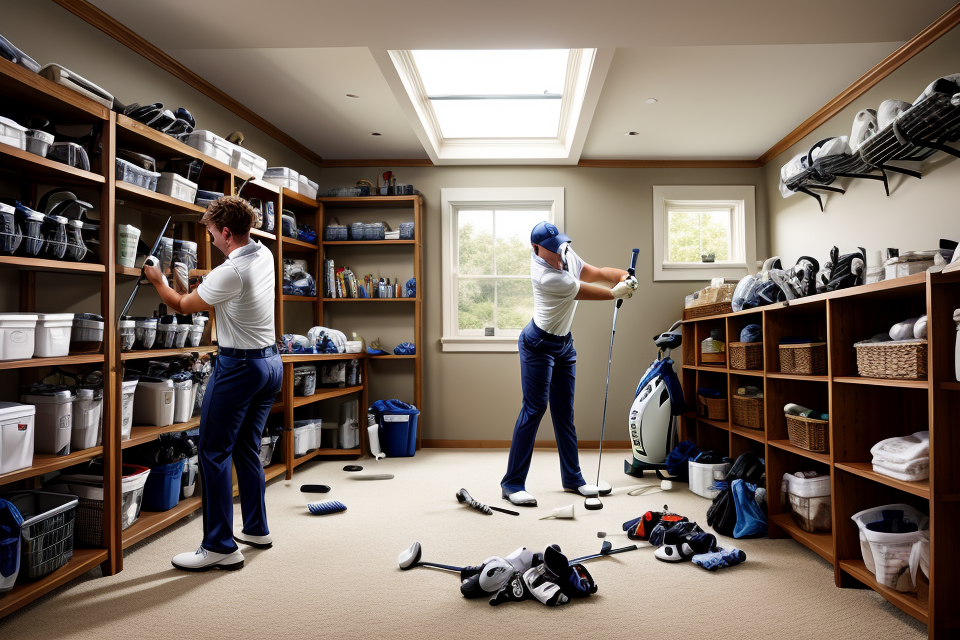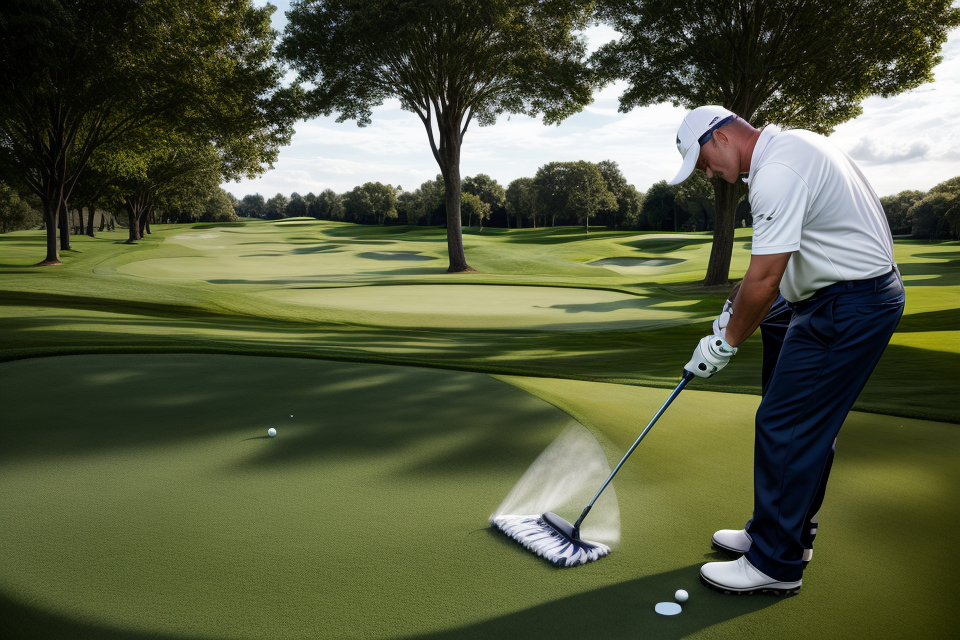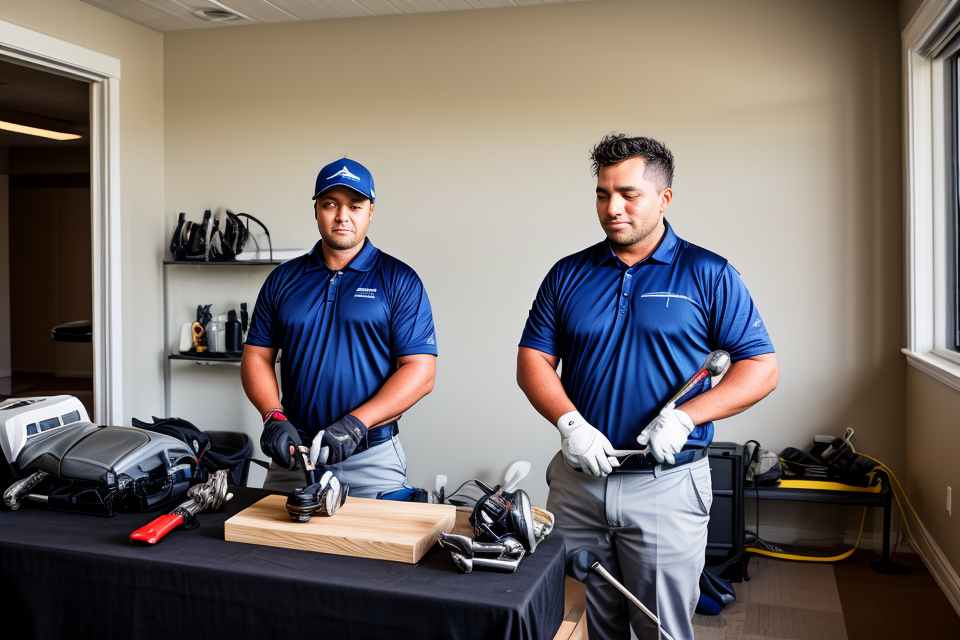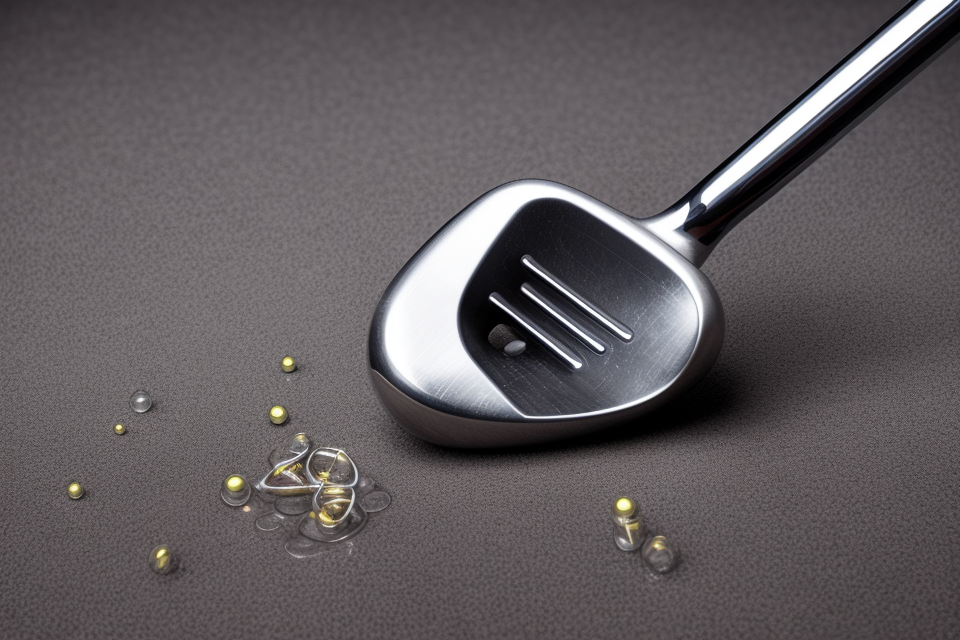
As any golfer knows, having the right equipment is crucial to playing your best game. And while the clubs themselves are a significant investment, proper maintenance is essential to keep them in top condition. From cleaning to oiling to storing, there are several steps you can take to ensure your clubs are always ready to perform at their best. In this article, we’ll explore the most effective ways to clean and care for your golf clubs, so you can play your best game every time.
Understanding the Importance of Golf Club Maintenance
Why Golf Club Maintenance Matters
- Maintaining your golf clubs is crucial for optimal performance.
- Golf clubs are exposed to various environmental conditions that can cause wear and tear.
- Regular maintenance can prevent damage, improve the longevity of your clubs, and ensure consistent ball flight.
- Poorly maintained clubs can lead to decreased accuracy, distance, and overall performance.
- Regular cleaning and maintenance can also help prevent injuries, such as wrist and elbow pain, caused by gripping a dirty or worn-out club.
- Taking care of your golf clubs is an investment in your game and can save you money in the long run by avoiding costly repairs or replacements.
- Maintenance can also enhance the aesthetic appeal of your clubs, making them look newer and more appealing.
- Regular maintenance can also help you identify any potential issues with your clubs, such as misaligned clubs or worn-out grips, allowing you to address them before they become major problems.
- By maintaining your golf clubs properly, you can ensure that they perform at their best, allowing you to improve your game and enjoy your time on the golf course.
The Impact of Poor Maintenance on Golf Club Performance
Proper maintenance is crucial to ensuring that your golf clubs perform optimally. Failure to maintain your golf clubs can have a significant impact on their performance. Here are some of the ways in which poor maintenance can affect your golf clubs:
- Rust and Corrosion: Rust and corrosion can cause significant damage to your golf clubs. Over time, these elements can weaken the metal components of your clubs, affecting their performance and potentially even causing damage to the shaft or head.
- Dullness of the Club Head: A dull club head can result in poor contact with the golf ball, leading to decreased distance and accuracy. Dullness can be caused by poor cleaning or storage techniques, or by using the wrong type of cleaning materials.
- Worn-Out Grips: Worn-out grips can cause your hands to slip during your swing, leading to a loss of control and accuracy. Additionally, worn-out grips can cause discomfort and blisters, affecting your ability to play at your best.
- Dirty Club Face: A dirty club face can lead to poor contact with the golf ball, resulting in decreased distance and accuracy. Additionally, a dirty club face can cause your ball to veer off course, affecting your overall game.
- Loose or Damaged Club Parts: Loose or damaged club parts can affect the performance of your golf clubs. For example, a loose grip can cause your hands to slip during your swing, while a damaged shaft can affect the accuracy and distance of your shots.
In conclusion, poor maintenance can have a significant impact on the performance of your golf clubs. To ensure optimal performance, it is important to follow proper cleaning and maintenance techniques, such as using the right cleaning materials and storing your clubs properly. By doing so, you can extend the life of your golf clubs and improve your overall game.
Types of Golf Club Maintenance
Cleaning Your Golf Clubs
Cleaning your golf clubs is an essential part of maintaining them for optimal performance. Over time, dirt, dust, and debris can accumulate on the club’s surface, which can affect its overall performance. Therefore, it is important to clean your golf clubs regularly to ensure that they are in good condition and performing at their best.
Different Techniques for Cleaning Different Parts of the Club
Different parts of the golf club require different cleaning techniques. For example, the clubhead and shaft may need to be cleaned using a soft brush or cloth, while the grip may require a more aggressive cleaning solution. It is important to use the right cleaning technique for each part of the club to avoid damaging it.
One effective technique for cleaning the clubhead is to use a soft brush or cloth to gently remove any dirt or debris that has accumulated on the surface. This can be done by hand or with the use of a cleaning solution.
The shaft can be cleaned using a soft cloth or brush to remove any dirt or debris that has accumulated on its surface. It is important to avoid using any aggressive cleaning solutions or tools that could damage the shaft.
The grip is another part of the golf club that requires special attention when cleaning. Over time, sweat and dirt can accumulate on the grip, which can affect its performance. To clean the grip, you can use a mixture of warm water and mild soap to gently scrub away any dirt or debris. It is important to make sure that the grip is completely dry before using the club again to avoid any slipping or discomfort during play.
Using the Right Cleaning Solutions and Tools
Using the right cleaning solutions and tools is essential when cleaning your golf clubs. It is important to avoid using any harsh chemicals or abrasive cleaning solutions that could damage the club’s surface or finish. Instead, you should use gentle cleaning solutions that are specifically designed for golf clubs.
In addition to using the right cleaning solutions, it is also important to use the right tools when cleaning your golf clubs. For example, you may need to use a soft brush or cloth to gently remove any dirt or debris from the club’s surface. You may also need to use a specialized tool to clean the grip or other parts of the club.
Overall, cleaning your golf clubs is an important part of maintaining them for optimal performance. By using the right cleaning solutions and tools, and following the right techniques for cleaning different parts of the club, you can ensure that your golf clubs are in good condition and performing at their best.
Inspecting Your Golf Clubs
Inspecting your golf clubs is an essential aspect of maintaining them for optimal performance. By regularly inspecting your clubs, you can identify any issues that may affect their performance and take the necessary steps to address them.
Identifying Common Issues with Golf Clubs
Some common issues that you may encounter when inspecting your golf clubs include:
- Rust and corrosion: These can affect the overall performance of your clubs and should be addressed as soon as possible.
- Worn grips: A worn grip can affect your control of the club and should be replaced regularly.
- Bent or damaged shafts: A bent or damaged shaft can affect the accuracy and distance of your shots and should be straightened or replaced if necessary.
- Loose or broken clubs: A loose or broken club can be dangerous and should be repaired or replaced immediately.
Tips for Properly Inspecting Your Clubs
To properly inspect your golf clubs, follow these tips:
- Start by wiping down your clubs with a soft, dry cloth to remove any dirt or debris.
- Inspect the clubhead for any signs of wear or damage, such as scratches or dents.
- Check the shaft for any bends or damage, and make sure it is secured tightly to the clubhead.
- Examine the grip for any signs of wear or damage, such as cracks or slippage.
- Finally, take a few practice swings with each club to ensure that they are functioning properly.
By following these tips, you can effectively inspect your golf clubs and identify any issues that may affect their performance.
Storage and Protection of Your Golf Clubs
Proper storage techniques are essential to ensure that your golf clubs remain in good condition and ready for use at all times. The following are some tips on how to store your golf clubs safely:
Proper Storage Techniques
- Store your golf clubs in a dry, cool place: It is essential to keep your golf clubs away from direct sunlight and moisture. The ideal storage place should be dry, cool, and well-ventilated. This will prevent rusting and corrosion of the clubs’ metal parts.
- Use a golf club bag: A golf club bag is designed to protect your clubs during transportation and storage. It provides cushioning and support to the clubs, preventing them from getting damaged. The bag should be clean and dry before storing the clubs.
- Store your clubs vertically: Storing your golf clubs vertically is the best way to ensure that they remain in good condition. This position prevents the clubs from getting scratched or dented. You can use a golf club holder or a wall-mounted rack to store your clubs vertically.
- Inspect your clubs regularly: Before storing your golf clubs, inspect them for any damage or wear and tear. Look for any signs of rusting, denting, or cracking. If you notice any damage, clean and repair the clubs before storing them.
Protecting Your Clubs During Transportation
Transporting your golf clubs can be a daunting task, especially if you have to travel long distances. Here are some tips on how to protect your clubs during transportation:
- Use a golf club bag: A golf club bag is designed to protect your clubs during transportation. It provides cushioning and support to the clubs, preventing them from getting damaged. The bag should be clean and dry before storing the clubs.
- Wrap your clubs in a towel: Wrapping your golf clubs in a towel can help protect them from scratches and dents. The towel will absorb any shocks and vibrations that may occur during transportation.
- Use a golf club protector: A golf club protector is a sleeve that covers the shaft of your golf club. It protects the club from getting scratched or dented during transportation. You can purchase a golf club protector from a golf shop or online store.
- Disassemble your clubs: If you have to transport your golf clubs in a car, it is best to disassemble them before transportation. This will help prevent the clubs from getting damaged during transportation. Make sure to label each club part so that you can easily assemble them when you reach your destination.
Maintaining the Golf Clubs’ Mechanical Components
Adjusting and Replacing Club Parts
Ensuring that your golf clubs are in optimal condition is crucial for achieving the best performance on the golf course. Maintaining the mechanical components of your golf clubs is one of the most important aspects of club maintenance. Here are some tips for adjusting and replacing club parts:
- Check the loft and lie of your clubs regularly. If the loft or lie is not set correctly, it can affect the trajectory and spin of your shots. A professional club fitter can help you adjust the loft and lie of your clubs to ensure that they are set to your specifications.
- Check the shaft for any signs of damage, such as cracks or bends. If the shaft is damaged, it can affect the performance of your golf club. A damaged shaft should be replaced immediately to avoid any potential damage to the club head or other components.
- Inspect the club head for any signs of wear or damage. If the club head is damaged, it can affect the performance of the golf club. A damaged club head should be replaced immediately to ensure that the golf club is functioning properly.
Keeping Track of Your Clubs’ Performance
In addition to adjusting and replacing club parts, it is important to keep track of your golf clubs’ performance. By keeping track of your clubs’ performance, you can identify any issues that may be affecting your shots and take corrective action. Here are some tips for keeping track of your clubs’ performance:
- Keep a record of your shots. By keeping a record of your shots, you can identify any patterns or trends that may be affecting your performance. This can help you identify any issues with your golf clubs that may be affecting your shots.
- Use a launch monitor or ball flight tracker. A launch monitor or ball flight tracker can provide valuable data on your shots, including ball speed, spin rate, and trajectory. This data can help you identify any issues with your golf clubs that may be affecting your shots.
- Get fitted for new clubs regularly. As your swing changes over time, your golf clubs may need to be adjusted or replaced to ensure optimal performance. Getting fitted for new clubs regularly can help you identify any issues with your current clubs and ensure that you are using the best equipment for your game.
Common Problems with Golf Clubs and How to Fix Them
The Yellowing of Golf Clubs
Causes of Yellowing
The yellowing of golf clubs is a common problem that can be caused by several factors. One of the main causes is exposure to sunlight, which can cause the resin in the club’s shaft to break down and turn yellow. This can also be caused by using water that is high in minerals, which can react with the shaft and cause it to turn yellow over time.
How to Prevent and Reverse Yellowing
To prevent yellowing, it is important to store your golf clubs in a cool, dry place, away from direct sunlight. It is also important to use clean, fresh water to rinse your clubs after use, and to avoid using harsh chemicals or cleaners that can damage the shaft.
If your golf clubs have already started to yellow, there are several ways to reverse the process. One effective method is to use a specialized cleaner designed specifically for golf clubs. These cleaners contain chemicals that can break down the yellowing resin and restore the club’s original color. Another method is to use a mixture of equal parts white vinegar and water to clean the club, which can help to remove the yellowing and restore the shaft’s original color.
Golf Club Grooves
The Importance of Grooves
Golf club grooves are an essential component of the golf club that can significantly impact the performance of the club. The grooves on the clubface are designed to create backspin, which helps the ball to stop on the green and provides better control over the shot. The grooves also help to prevent the ball from rolling off the clubface, which can result in a lost shot.
Cleaning and Maintaining Grooves
Cleaning and maintaining the grooves on your golf clubs is crucial to ensure optimal performance. Here are some tips on how to clean and maintain the grooves on your golf clubs:
- Use a soft, dry cloth to wipe away any dirt or debris that may have accumulated on the grooves.
- Avoid using water or any other liquid to clean the grooves, as this can damage the clubface and reduce its effectiveness.
- Use a groove cleaner to remove any excess dirt or debris that may be stuck in the grooves. Be sure to follow the instructions on the cleaner to avoid damaging the clubface.
- Use a club brush to gently brush away any loose dirt or debris that may be stuck in the grooves.
- After cleaning the grooves, use a microfiber cloth to wipe away any remaining dust or debris.
By following these tips, you can ensure that your golf clubs‘ grooves are clean and well-maintained, which can help to improve your overall performance on the golf course.
Rust and Corrosion
Causes of Rust and Corrosion
Rust and corrosion are common problems that can affect the performance of golf clubs. Rust is a form of iron oxide that forms when iron or steel reacts with oxygen and water. Corrosion, on the other hand, is a more general term that refers to the degradation of a material, typically due to a chemical reaction or electrochemical process.
In the case of golf clubs, rust and corrosion can occur for a variety of reasons. One common cause is exposure to moisture, whether from rain, dew, or sweat. Another cause is the use of saltwater or chlorinated water, which can accelerate the corrosion process. Additionally, storing golf clubs in damp or humid environments can also contribute to rust and corrosion.
Preventing and Treating Rust and Corrosion
To prevent rust and corrosion from damaging your golf clubs, it’s important to take proper care of them. Here are some tips for preventing and treating rust and corrosion:
- Store your golf clubs in a dry, ventilated area, away from moisture and humidity.
- Use a cloth or towel to wipe down your golf clubs after each use, to remove any excess moisture or dirt.
- Consider using a rust-resistant coating or protective cover for your golf clubs, especially if you live in an area with high humidity or frequent rain.
- If you notice rust or corrosion on your golf clubs, clean them immediately with a rust-removing solution or a mixture of vinegar and water.
- Once the rust or corrosion is removed, apply a lubricant or protective coating to prevent further damage.
By following these tips, you can help ensure that your golf clubs remain in good condition and continue to perform at their best.
Recap of Key Points
When it comes to golf clubs, proper maintenance is key to ensuring optimal performance. Neglecting to clean and maintain your clubs can lead to a range of problems, including:
- Dirt and debris buildup: This can affect the club’s overall performance and potentially cause damage to the club’s components.
- Rust and corrosion: Exposure to moisture and humidity can cause rust and corrosion to form on the club’s metal components.
- Grip slippage: Over time, the grip on your golf clubs can become loose or slippery, affecting your ability to control the club during your swing.
- Worn or damaged club components: The various components of your golf clubs, such as the clubhead or shaft, can become worn or damaged over time if not properly maintained.
To avoid these common problems, it’s important to regularly clean and maintain your golf clubs. This includes wiping down the club with a soft cloth after each use, cleaning the clubhead and shaft with a specialized cleaning solution, and periodically inspecting the club for any signs of damage or wear. By taking these steps, you can help ensure that your golf clubs are in top condition and ready to perform at their best.
Tips for Continuing to Maintain Your Golf Clubs
- Keep your golf clubs clean and dry
- Inspect your golf clubs regularly for any damage or wear
- Store your golf clubs in a dry, safe place
- Use a golf club cover to protect your clubs from scratches and other damage
- Avoid exposing your golf clubs to extreme temperatures
- Avoid using harsh chemicals or abrasive cleaners on your golf clubs
- Have your golf clubs professionally cleaned and serviced regularly
- Consider investing in a golf club maintenance kit
- Consider purchasing a golf club repair kit
- Consider purchasing a golf club shaft cutter
- Consider purchasing a golf club groove cleaner
- Consider purchasing a golf club brush
- Consider purchasing a golf club cleaning solution
- Consider purchasing a golf club wax
- Consider purchasing a golf club microfiber cloth
- Consider purchasing a golf club polish
- Consider purchasing a golf club tee
- Consider purchasing a golf club towel
- Consider purchasing a golf club wrench
- Consider purchasing a golf club plier
- Consider purchasing a golf club tool kit
- Consider purchasing a golf club grip tape
- Consider purchasing a golf
Final Thoughts on the Importance of Golf Club Maintenance
- Regular maintenance is crucial for optimal performance and longevity of golf clubs.
- Neglecting maintenance can lead to decreased performance, reduced distance, and even damage to the clubs.
- Investing time and resources into regular maintenance will not only improve the function of the clubs but also their aesthetic appeal.
- Consistent maintenance also helps to prevent costly repairs or replacements in the future.
- It is important to regularly inspect the clubs for any signs of wear or damage and address any issues promptly.
- By prioritizing maintenance, golfers can ensure that their clubs are always in top condition and ready to perform at their best.
FAQs
1. How often should I clean my golf clubs?
Answer: It is recommended to clean your golf clubs after every use, especially if they have been exposed to wet or dirty conditions. This will help prevent the buildup of dirt and debris that can affect the performance of your clubs.
2. What is the best way to clean my golf clubs?
Answer: The best way to clean your golf clubs is to use a soft, damp cloth to wipe away any dirt or debris. You can also use a specialized golf club cleaning solution to ensure that all surfaces are thoroughly cleaned. Be sure to pay extra attention to the grip, clubhead, and any moving parts.
3. How do I store my golf clubs when they are not in use?
Answer: When storing your golf clubs, it is important to make sure they are dry and clean. You can use a golf club cover or place them in a dry, well-ventilated area. It is also a good idea to loosen the grip and remove any accessories, such as golf balls or tees, before storing them.
4. Can I use household cleaners to clean my golf clubs?
Answer: No, it is not recommended to use household cleaners to clean your golf clubs. Many household cleaners can damage the finish or other parts of your clubs, and may also leave residue that can affect their performance. It is best to use a specialized golf club cleaning solution that is specifically designed to be safe and effective for use on golf clubs.
5. How can I maintain the condition of my golf clubs?
Answer: To maintain the condition of your golf clubs, it is important to regularly clean and inspect them for any signs of wear or damage. You should also consider having them professionally serviced and regripped periodically to ensure that they are performing at their best. By taking good care of your golf clubs, you can help improve your game and extend their lifespan.


